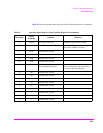
248
S:\agilent\8920\8920b\PRGGUIDE\BOOK\CHAPTERS\advoper.fb
Chapter 5, Advanced Operations
Status Reporting
Transition Filters are read-write. Transition Filters are unaffected by a *CLS
(clear status) command or queries. The Transitions Filters are set to pass positive
transitions (PTR) at power on and after receiving the *RST (reset) command (all
16 bits of the PTR register set to 1 and all 16 bits of the NTR register set to 0).
Event Register. The Event Register captures bit-state transitions in the Condition
Register as defined by the Transition Filters. Each bit in the Event Register
corresponds to a bit in the Condition Register, or if there is no Condition Register/
Transition Filter combination, each bit corresponds to a specific condition in the
Test Set. Bits in the Event Register are latched, and, once set, they remain set until
cleared by a query of the Event Register or a *CLS (clear status) command. This
guarantees that the application can’t miss a bit-state transition in the Condition
Register. There is no buffering; so while an event bit is set, subsequent transitions
in the Condition Register corresponding to that bit are ignored. Event Registers
are read-only. Event Registers in the Test Set are either 8 or 16 bits long and may
contain unused bits. All unused bits return a zero value when read.
Event Enable Register. The Event Enable Register defines which bits in the Event
Register will be used to generate the Summary Message. Each bit in the Enable
Register has a corresponding bit in the Event Register. The Test Set logically
ANDs corresponding bits in the Event and Enable registers and then performs an
inclusive OR on all the resulting bits to generate the Summary Message. By using
the enable bits the application program can direct the Test Set to set the Summary
Message to the 1 or TRUE state for a single event or an inclusive OR of any group
of events. Enable Registers are read-write. Enable Registers in the Test Set are
either 8 or 16 bits long and may contain unused bits which correspond to unused
bits in the associated Event Register. All unused bits return a zero value when read
and are ignored when written to. Enable Registers are unaffected by a *CLS (clear
status) command or queries.
Summary Message Bit. The Summary Message is a single-bit message which
indicates whether or not one or more of the enabled events have occurred since the
last reading or clearing of the Event Register. The Test Set logically ANDs
corresponding bits in the Event and Enable registers and then performs an
inclusive OR on all the resulting bits to generate the Summary Message. By use of
the enable bits, the application program can direct the Test Set to set the Summary
Message to the 1, or TRUE, state for a single event or an inclusive OR of any
group of events. The Summary Message is TRUE when an enabled event in the
Event Register is set TRUE. Conversely, the Summary Message is FALSE when
no enabled events are TRUE. Summary Messages are always seen as bits in
another register.


















